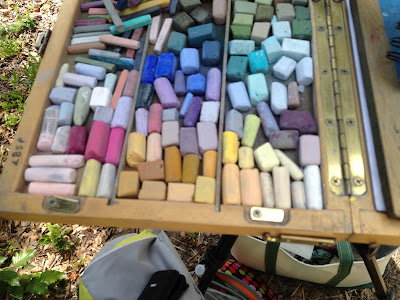 |
| Watercolor under-painting |
Last week we discovered the expressive pastel paintings of
Lyn Asselta.
Lyn is the president and founder of
First Coast Pastel Society and was the featured artist of A Brush with Nature at the Jacksonville Arboretum.
 |
| Arboretum Path, pastel on paper, ©2012 Lynn Asselta |
Lyn's pastel painting workshop at the Jacksonville Arboretum was fun for all the participants. Lyn was so busy encouraging her students that her own painting waited to be completed until after the event.
Today, we'll look at her finished painting and ask Lyn some questions about her motivations, her background, and her process.
Hello Lyn!
Since you are one of my favorite painters and a master of plein air painting in pastel, I'd love to find out more about you and your work. Thanks for answering some
questions for us.
What was the catalyst for becoming an artist and a teacher?
Lyn: I
think I've always wanted to be an artist, but I also wanted to share
that with other people. So, I started out as an elementary school art
teacher and then gradually transitioned into teaching workshops for
adults. I love being able to watch someone get excited about learning
to paint or draw.
Has pastel always been your medium of choice?
Lyn: I've
worked with a lot of different mediums in the past. I started out as a
calligrapher, then did a little residential drafting, I created large,
intricately-designed gourd vessels with pine-needle basketry for about
10 years, and then finally pulled my old pastel box out of the studio
closet and discovered sanded paper...that was the beginning of it for
me!
Why do you work outdoors?
Lyn: Honestly,
I work outdoors because I love it there. There is nothing quite like
standing next to my easel, hearing the birds and the wind in the trees
or the water swooshing up against the shore. It's peaceful, and I feel
like I'm where I'm supposed to be when I'm out there.
What location has been your favorite and why?
Lyn: As for a favorite
place, it's hard to say. I recently took a trip to Zion National Park
and fell in love with those enormous mountains, but every time I see a
new place I tend to fall in love with it, so maybe the answer is
wherever I happen to be!
What do you hope your students learn from you?
Lyn: I hope my students learn to be excited
about pastels and painting. To me, it's the excitement that is the
most important thing. Whenever I teach, the very best thing for me is
the look of excitement on a student's face when they've done something
they thought they couldn't do, or when they love what they've painted.
Are you ever fully satisfied with your work? How do you know when you're finished?
Lyn: Every
so often I finish a painting and I'm totally happy with it. But, more
often than not, I continue to wonder if there is anything else I need to
do to really make it special. As a painter, I'm ridiculously critical
of my own work. Sometimes I will go back and work on a painting after I
think it's "finished". Other times I will stack it against the wall
and hope that I feel differently about it a few months later. I'm
pretty particular about what I feel is good enough to go into a frame.
Knowing
when to finish a painting is tricky. With every single painting, there
is a time that I realize I've begun to work more slowly and
deliberately. The marks aren't as spontaneous anymore and I realize I'm
starting to evaluate every stroke. I've learned to pay attention at
this point. When I start to slow down, I know that I'm quickly coming
to the point where one more mark could disturb the integrity of the
whole painting. So, I try to stop before I make that one final mark.
Thank you so much for this peek into the mind of an artist.
Note: In comparing the watercolor under-painting (done in complementary colors) with the finished painting, notice that Lyn allows the under-painting to show, not fully covering it. This makes the colors sparkle next to one another.
Using watercolors for the under-painting simplifies the process and dries almost immediately, so the pastel layer can be added.



